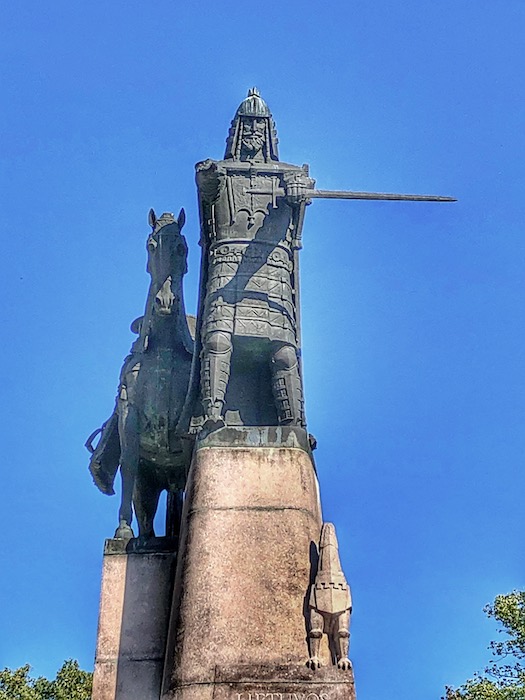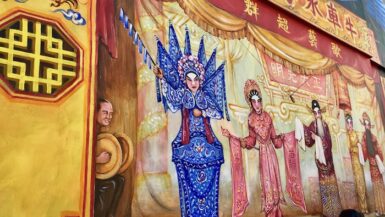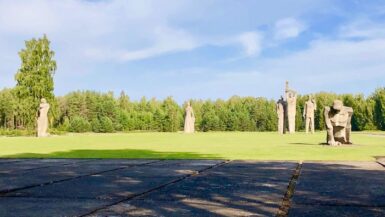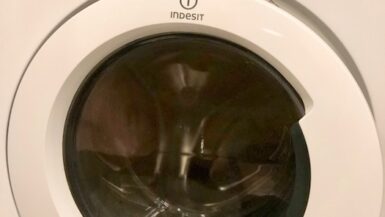August 31, 2019
Vilnius’ old town is best explored on foot. As I walked from my apartment to Cathedral Square where I was to meet the tour guide for the morning, I was captivated by the scenes of daily life and architecture that I saw along the way. Within minutes, I knew I was really going to like it here.
The neo-classical Cathedral of St. Stanislaus and St. Ladislaus is the most important Roman Catholic building in Lithuania. Initially built in 1251 on the site of a pagan temple, the exterior, except for the statuary, is relatively plain. The same can’t be said for the interior, particularly some of the chapels. The High Baroque Chapel shouldn’t be missed. Since I had a bit of time before the tour (early, as usual), I took my time strolling around the church studying the art and icons. Lighting wasn’t the best, so photographs don’t really do it justice.
Just outside of the Cathedral, in the square is the bell tower. Originally a defensive tower from the 13th century, it was converted into the bell tower and added onto (thus the different architecture) in the 19th century. I’ve been told that the view from the top is incredible, but I didn’t partake because (a) it was closed; (b) even if open, it costs money; and, most importantly, (c) I was told that the staircase is very narrow, a bit rickety and not a good climb for someone with a fear of heights.
Rounding out Cathedral Square, towards the rear of the Cathedral, was the Palace of the Grand Dukes of the Duchy of Lithuania, newly opened after a multi-year refresh. Unfortunately, I didn’t have enough time to check it out, so I’ll have to put it on my list for next time. As I walked toward the meeting point of the tour, I saw this man standing a grassy clearing among the trees in the nearby park playing his heart out to no one in particular. He wasn’t busking, it seemed he was just playing for the beauty of the music. He was good too.
Ugne, the guide from Vilnius Free Walking Tours, met the rather large group at the monument of Gediminas, the Grand Duke of Lithuania who founded Vilnius in 1323. She was a fun young woman who had lots of information to share and a passion for the history and politics of the city and country. After its founding in the 14th century, Vilnius became the capital of the Grand Duchy of Lithuania. At the time, Lithuania was the largest country in Europe – it’s now average-sized. Because it was the capital of a wealthy country, the city was encircled by a defensive wall for protection. Later, when it seemed it was no longer necessary, the wall was torn down and only a few portions remain. In the 16th century, Lithuania united with Poland, creating a Commonwealth, which existed until the 18th century. From the 18th century until its independence in 1918 (which didn’t last), Lithuania was occupied by several different countries. Lithuania once again reclaimed its independence in 1990. It was a long, hard fight.

Our walking tour took us to Vilnius University, the oldest school in Eastern Europe. Established by Jesuit monks from Rome in the 16th century, the school is a primary reason why Vilnius, and Lithuania, is predominantly Catholic (different than the surrounding countries). The tower associated with the University is another good place to take in sweeping views of the city. Lithuania is a big proponent of education, which is mandatory and free up to the age of 16. Post-secondary education is also free, but with limitations – you can only get one bachelor’s degree, one master’s degree, and one Ph.D. for free. If you want to be an overachiever and get a second bachelor’s, master’s or Ph.D., then you have to pay for it yourself. As for languages, both English and Lithuanian are mandatory studies. Students get to choose which second foreign language they wish to study. Russian as a foreign language is not as popular as it once was – there are still hard feelings over the Soviet-occupation (extremely justified).
In the 17th century, Vilnius was known as North Jerusalem as a sizable amount of its population was Jewish. The Great Synagogue was built in 1572 and could house 5,000 worshipers. It was heavily damaged in WWII but was finally destroyed by the Soviets during the occupation following the war. As distressing as it is, most of the buildings revolving around the Jewish community (including the ghettos) were destroyed, leaving empty spaces around the city. The area previously occupied by the Great Synagogue is a part of a school playground.
Within the first three months of the Nazi occupation of Vilnius, half of the Jewish population was murdered (35,000 individuals). Over the next years of the war, another 29,000 Jews were killed; only 6,000 survived. Currently, the Jewish community in Lithuania totals approximately 5,000; 80% of the community live in Vilnius.
As we meandered through the back streets, we ended up in what looked like someone’s backyard. In the center was an exquisite statue of a woman sitting on a large bear. Although the statue is a bit provocative for a relatively conservative community, it is a representation of the Lithuanian pagan goddess of the forests. Lithuania was actually one of the last European countries to support pagan rituals. Truth be told, a percentage of the population likely still follow a pagan-based religion.

Vilnius is home to 40 churches. The Church of St. Casimir is one of the most beautiful examples of baroque architecture. Construction began in 1604 and the church burned down no less than three times. It was reconstructed in the mid-1700s and was a functioning catholic church until the mid-1800 when it was transformed into a Russian Orthodox Church. In 1915, the church was turned into a Lutheran church for the German army, was returned to the Jesuits several years later, and then closed in 1949 by the Soviets. After they destroyed the entire interior of the church, the Soviets ultimately turn the church into an Atheism museum. In 1988, the St. Casimir was returned to the Catholic Church and was reconstructed in 1991. Interestingly, the top of the church is crowned with a Lithuanian cross (double stylized cross), which pays homage to the country’s pagan roots.
Our wanderings took us by the old ramparts of the city wall to a lookout over the city.
The group crossed over a canal to reach Užupis, an independent republic much like Christiania in Copenhagen. Užupis means “beyond the river” or on “the other side of the river” and is very popular with an artist community. The area declared itself as an independent republic on April 1, 1998 (yes, April Fool’s Day – the irony is not lost). It has its own flag (a hand with a hole in the middle), unofficial currency, a President, unofficial ambassadors from other countries/republics, an army of eleven men, and a constitution. There is an unwritten requirement that you smile while in Užupis. That levity is also reflected in its constitution. For example, the constitution states that (a) everyone has the right to be unique; (b) everyone has the right to love and take care of a cat; however, a cat is not obliged to love its owner, but it must help in time of need; (c) everyone has a right to look after a dog until one of them dies and a dog has a right to be a dog; (d) everyone has the right to celebrate or not celebrate their birthday; (e) everyone has the right to love; and (e) everyone has the right to die, but this is not an obligation. There are a total of 41 rights given by the constitution.
Of the 7,000 residents of Užupis nearly 1,000 are artists. Thus, art is a focus and there are many galleries and art installments around town. Some of the art is controversial, some is beautiful, and some doesn’t make sense. I did find the statue of the first known backpacker (Jesus) amusing and disrespectful all at the same time, while the rocking zebra unicorn was beloved by children, and the colorful stylized mural of an aboriginal woman was stunning.
As we left the area, we were reminded that art reigns supreme (Mona Lisa emoji) and that smiling is a must while in the Republic of Užupis.

On our way back into the old town and the end of our tour, we passed St. Anne’s Church and the Church of St. Francis and St. Bernard, both constructed in gothic styles. While St. Anne’s is strictly gothic, a mix of flamboyant gothic and brick gothic, the Bernardine church is gothic with renaissance and baroque features. The mash-up of styles makes the side-by-side churches a unique photo opp.

During the tour, I met a very nice woman from Helsinki, Finland. We determined that we were both doing the afternoon “Alternative Vilnius” tour with the same guide, so we teamed up to find the nearest restroom and got a quick bite to eat (yes, I consider gelato as a “quick bite to eat”) before the next tour started. After gathering at Gediminas’ monument, Ugne took the group to the spot in Cathedral Square, which was the starting point of the Baltic Way, the human chain that stretched from Vilnius to Riga signifying the unity of the three Baltic countries against Soviet oppressors. It is said that if you spin clockwise three times while standing on the spot, you will find happiness and return to Vilnius. I, of course, took my turn at spinning on the spot.

This afternoon’s tour took us outside the old town and into other areas of the city. We started by taking a bus across the river into one of the older sections that sits in the shadow of new skyscraper offices and residences. The area, known as Šnipiškés, consists of 50-60 old wooden houses, many still without electricity and/or running water. As the years go by, houses are being bought up and residents pushed out as new construction creeps closer and closer. Despite the lack of utilities, many of the residents do not want to sell or move – this is the way they’ve always lived and they don’t want it to change. Some of the houses are well-maintained, some are not. Some of the homes show indications of how they were divided to house several families during Soviet times (i.e. if four families lived in the house, each quarter was painted in a different color scheme).
As we walked through the high grass and weeds around some of the houses, I think I got into a little bit of poison ivy or poison oak based on the itchy rash that later appeared around my ankles. We also came across another type of “weed” growing wild among the trees.

Many of the residents are older, the younger generation has moved and stayed away. While I personally wouldn’t consider living without electricity and running water for any length of time, I can appreciate these people’s desire to maintain the lifestyles to which they have become accustomed. But, progress, or what we consider to be progress, is closing in on them quickly. Unfortunately, I foresee that in not too many years down the road, Šnipiškés will be nothing but a memory.
We took a snack/restroom break in a shopping center built into one of the skyscrapers and then journeyed to the top floor of the Radisson Blu Hotel for a spectacular view of the city. Not sure what it is about Radisson hotels, but they always seem to have the best views from their rooftop/top floor bars.
Once the tour was over, Jessica, the woman from Helsinki, and I decided to walk back to the old town by way of the river walk. We’d seen a bunch of food trucks and thought it might be a good place to stop for a snack (since we’d only had gelato for lunch).
Just before we reached the food trucks, we came across this version of a houseboat. Now you know what to do if you have an old camper lying around.
It seemed that the Vilnius City Festival atmosphere had spread down to the river. Not only were there food trucks but there were also several beer gardens, a kids’ play area, and a music venue. Food options ran the gambit from freshly shucked oysters to sausages to barbeque and Mexican food. Jessica and I shared a snack, relaxed in deck chairs, and chatted about traveling and our lives until the music became too loud and not our style.
Our walk back into old town included meandering up and down the vendor stalls of the main street of the Festival. There were all kinds of vendors – food, jewelry, clothing, art and almost anything else that comes to mind (except there were no appliance or heavy machinery vendors). All the while, Jessica and I chatted and became fast travel friends.
Several hours after we had separated from the tour group, Jessica and I said our goodbyes – she was off to have a foot massage from a shop we’d seen earlier. I continued my walk and came across a fitness fair. In one area there was a stage where a dance competition was going on, and in another area, there were booths where kids could shoot goals into a hockey net or take shots at a basketball hoop. In yet another area, there was some type of fitness competition being held, either that or it was just a lot of sweaty men with great physiques and no shirts who happened to be in the same spot at the same time.
The well-tanned men aside, it was still the architecture that took my breath away.
The Festival stalls seemed to stretch for miles. There were music venues along the way (some with music I could tolerate) and scores of people milling around. I’m not one for crowds, but people-watching kept me occupied for a long time as I strolled toward Cathedral Square.
As I left Cathedral Square and headed back to the apartment, I was a bit tired and my feet hurt. No wonder, according to my Fitbit, I’d walked well over 12 miles.






















































































Vilnius looks like such an interesting city! Really cool architecture. There’s still so much I have to explore in Europe, so many countries, so little time! I’ll have to add Vilnius to my bucket list 🙂
Definitely add Vilnius to your list. I loved the city. Thanks for taking the time to read and comment on my blog post. I appreciate it a lot. 🙂